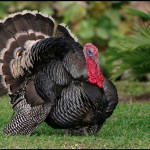 There is a rural legend that domesticated turkeys are so dumb that they will drown themselves while looking up at the rain with their mouths open.
There is a rural legend that domesticated turkeys are so dumb that they will drown themselves while looking up at the rain with their mouths open.
The term “birdbrain†emerged from the fact that, compared to humans, bird brains are extremely small. Most birds have pea-sized brains with the largest belonging to parrots. Ostrich brains weigh 41 grams, while human brains typically weigh 1,500 grams (3.3 lbs.). Bird brains lack the massive cerebral hemispheres, which enable human consciousness, memory, emotion, logic/mathematical skills, linguistics, music, creative arts, self-awareness and spiritual awareness.
It has long been thought that all (or nearly all) of avian behavioral and survival skills were controlled by the poorly understood, catchall term, “instinct.†In its extreme application, birds would be senseless living automatons controlled by instinctive behavior. It remains a mystery as to how much they are aware of who they are or what they are doing.
However, some recent studies with parrots ravens and crows have shown that, even lacking the neocortex, they are capable of cognitive skills and deductive reasoning that was never deemed possible. This will not come as a surprise to Native Americans who held birds in much higher esteem than Whites.
In Noah Strycker’s, The Thing With Feathers, he divides stories about birds into three categories; body, mind and spirit.
In the “mind†category, he writes about the amazing memory skills of the Clark’s Nutcracker. The birds depend on pine nuts to survive long, frozen winter climate. He noted that a single bird can stash as many as 5,000 mini-caches, which can contain tens of thousands of pine nuts. The caches are not marked and are typically covered with snow.
“It’s a radical mental feat: Nutcrackers somehow remember exactly where thousands of different clumps of seeds are buried without a single yellow sticky note, global-positioning waypoint, or silly mnemonic.”
 In the “spirit†category, Strycker describes the courtship behavior of Bowerbirds. The males go through a process of creating elaborate “bowers†trying to seduce interested females. The bowers are made of attractive natural materials as well as man-made items that may be bright or artistic. They are not averse to stealing coveted items from neighbors in hopes of increasing their chances of attracting a suitable mate or mates!
Also in the “spirit†category, Strycker describes the amazing behavior of the Wandering Albatross. Although the birds live in solitude, they mate for life and mysteriously get together every two years to mate and raise their chicks. How they navigate or locate each other is pure mystery.
Arctic terns hatch in the Arctic region, mature enough in one season to be able to fly 12,000 miles south to summer in the Antarctic region. They obviously have a mysterious, internal biological GPS mechanism that allows them to navigate unknown territory.
 John Muir’s story about his little dog “Stickeen†ranks among the greatest dog stories. Loren Eiseley’s story about a mated pair of sparrow hawks deserves a similar ranking.
Eiseley was on an academic assignment to collect animal specimens deep in “canyon country.†He successfully trapped the male partner and caged it in order to send it to zoo or ornithology research org. However, the next morning he had a change of heart and carefully released the bird.
“IN THE NEXT second, after that long minute, he was gone. Like a flicker of light, he had vanished with my eyes full on him, but without actually seeing even a premonitory wing beat. He was gone straight into that towering emptiness and crystal that my eyes could scarcely bear to penetrate.  For another long moment, there was silence. I could not see him. The light was too intense. Then from far up somewhere a cry came ringing down.
 I was young then and had seen little of the world, but when I heard that cry my heart turned over. It was not the cry of the hawk I had captured; for, by shifting my position against the sun, I was now seeing further up. Straight out of the sun’s eye, where she must have been soaring restlessly above us for untold hours, hurtled his mate. And from far up, ringing from peak to peak of the summits over us, came a cry of such unutterable and ecstatic joy that it tingles among the cups on my quiet breakfast table.
 I saw them both now. He was rising to meet her. They met in a great soaring gyre that turned to a whirling circle and dance of wings. Once more, just once, their two voices, joined in a harsh wild medley of question and response, struck and echoed against the pinnacles of the valley. Then they were gone forever somewhere into the upper regions beyond the eyes of men.â€
 St. Francis of Assisi has been affectionately dubbed the, “Patron Saint of animals.†Perhaps this is justified because he regarded every bird egg, feather, wing-beat and heartbeat as indescribably perfect creations of the Creator of the universe.
Lowell H. Young
Author: Biodesign Out For A Walk
www.facebook.com/biodesignoutforawalk
www.biodesignoutforawalk.com
www.linkedin.com/LowellYoung
www.goodreads.com/BiodesignOutForAWalk